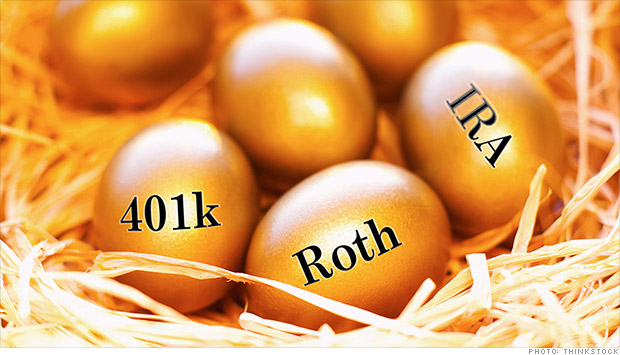
Having your retirement savings in a variety of accounts gives you more flexibility in managing your withdrawals and your tax bill.
NEW YORK (Money Magazine)
Once you determine how much of a saver you are, you have several more decisions to make -- including how to best take advantage of tax-deferred plans.
Decision No. 4: What's the best use of tax-deferred plans?
The decision: When it comes to your 401(k), IRA, and Roth IRA, you potentially face two decisions. One is divvying up your investments between taxable and tax-advantaged accounts. The other is when to tap each type of account.
Why it's important: You have virtually no control over what happens to tax rates. But you can reduce the drag that taxes can have on your investments.
Regardless of how Congress may change taxes in the future, you'll almost certainly continue to face different tax rates on different types of investments. All gains in 401(k)s and traditional IRAs are taxed at ordinary income rates when withdrawn (a top rate of 39.6% in 2013); outside of these plans, you face lower rates on long-term capital gains and dividends (a max of 20% in 2013).
Related: Middle class tax breaks on the line
You can minimize the tax man's take by keeping investments like stock index funds, stock ETFs, and dividend funds in taxable accounts to take advantage of long-term capital gains rates and holding bond funds and actively managed stock funds that trade a lot in tax-deferred accounts.
In retirement, the idea is to blunt the effect of taxes by tapping your nest egg in a tax-efficient manner. The traditional advice is to pull money from taxable accounts first, where you'll presumable pay the lower capital gains rate, then move on to tax-deferred accounts like 401(k)s and IRAs, and finally Roth IRAs. The balances in your tax-advantaged accounts will have more time to compound tax-free.
Best move: While these strategies can be effective -- Morningstar estimates that following both in retirement can up your income by roughly 8% -- stay flexible. In fact, says David Blanchett, Morningstar's head of retirement research, "you should maintain your target stocks/bonds mix first and then allocate your assets as best you can for tax efficiency."
Related: The other way to invest in a Roth IRA
Similarly, you don't want to be too rigid about withdrawals. In some years, for example, you may be able to sell taxable investments at a loss and use that loss to offset taxes on your 401(k) or IRA withdrawals. By liquidating taxable accounts early in retirement, you lose that flexibility. And once you reach age 70½, you're required to draw at least some money from your IRA and, unless you're still working, your 401(k).
Besides, you can't know what the tax system will look like down the road. Having savings in a variety of accounts that receive different tax treatment gives you more leeway for managing withdrawals -- and your tax bill -- later.
See more decisions you need to get right
Are you a saver or an investor?
How should you divide your money?
How much help do you really need?
How much can you draw from your savings? ![]()
First Published: February 11, 2013: 10:03 AM ET
Anda sedang membaca artikel tentang
How to use your retirement plans to lower your taxes
Dengan url
http://kasiatbuatsehat.blogspot.com/2013/02/how-to-use-your-retirement-plans-to.html
Anda boleh menyebar luaskannya atau mengcopy paste-nya
How to use your retirement plans to lower your taxes
namun jangan lupa untuk meletakkan link
How to use your retirement plans to lower your taxes
sebagai sumbernya


0 komentar:
Posting Komentar